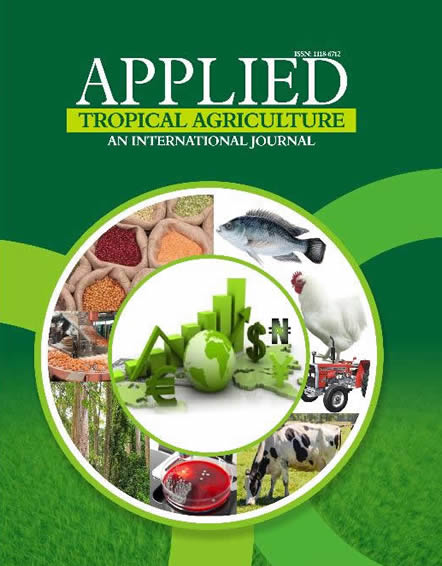Soils of the Southern Guinea Savanna Zone of Nigeria are inherently low in soil nitrogen and organic matter and crop
yields on these soils are low. Also, weed interference not only results in crop losses but also increases insect pest damage,
harvesting difficulties and crop contamination. This study was carried out at the Teaching and Research Farm of the
Agronomy Section, Kabba College of Agriculture in the year 2014, and repeated in the year 2015. The experiment was laid
out in a 5 × 4 factorial experiment in Randomized Complete Block Design (RCBD). Neem residue were applied at the
following rates; 0, 2.5, 5.0, 7.5 and 10 tons/ha. Weed control methods were (Atrazine (2.5 l/ha) at time of transplanting +
Hoeing at 4 weeks after transplanting (AT+H4WAT), Atrazine (2.5 l/ha) at time of transplanting + Paraquat (200g/l) at 4
week after transplanting (AT+P4WAT), Glyphosate (3l/ha) at 2 weeks before plough + Atrazine at transplanting
(G2WBP+AT) and No Weed Control (NWC). These gave 20 treatment combinations and were replicated thrice. Healthy
and uniform eggplant seedlings were transplanted at 30 days after sowing. The seedlings were transplanted at the rate of
one plant-per-hole at a spacing of 50 cm by 30 cm which make up 30 stands per plot of 6 m by 3 m (18 m2). The growth
parameters collected were plant height (cm), stem girth (cm), number of branches per plant and days to 50% at 1st
flowering. Yield parameters collected were number of fruits per plant, individual fruit weight (g), fruit yield per plant (kg)
and fruits yield per land area. Microbial population considered were fungi (sfu/g x 103), bacteria (cfu/g x 103) and, organic
matter (g/g). Weed characters observed were weed species, weed dry weight and weed control efficiency (WCE). Analysis
of variance (ANOVA) for RCBD was performed on the data collected. F-LSD was calculated at the probability levels of P ≤
0.05 to separate the means. From the findings of this work it can be concluded that eggplant do better with the application
of 7.5 to 10 t ha-1 of neem residue, since, there was no significant difference in the growth and yield performance of
eggplant with neem residue at 7.5 and 10 t ha-1. The recommended rate for neem residue application in eggplant cultivation
is therefore 7.5 ha-1 in the study area and related ecologies. All the weed control methods reduced weed infestations
significantly, but glyphosate at two weeks before ploughing plus atrazine at time of transplanting recorded most weed
control efficiency and thus suggested for the control of weeds in eggplant field in the study area and related ecologies.
PAPER TITLE :EFFECT OF NEEM RESIDUES AND WEED CONTROL METHODS ON SOIL PROPERTIES, WEED INFESTATION, GROWTH AND YI
APPLIED TROPICAL AGRICULTURE | VOLUME 21 NUMBER 3 2016
Paper Details
- Author(s) : Ogundare, S.K.1*, Hinmikaiye, A.S.1, Oladitan, T.O.2 and Agbona, A.I.1
- Abstract:


